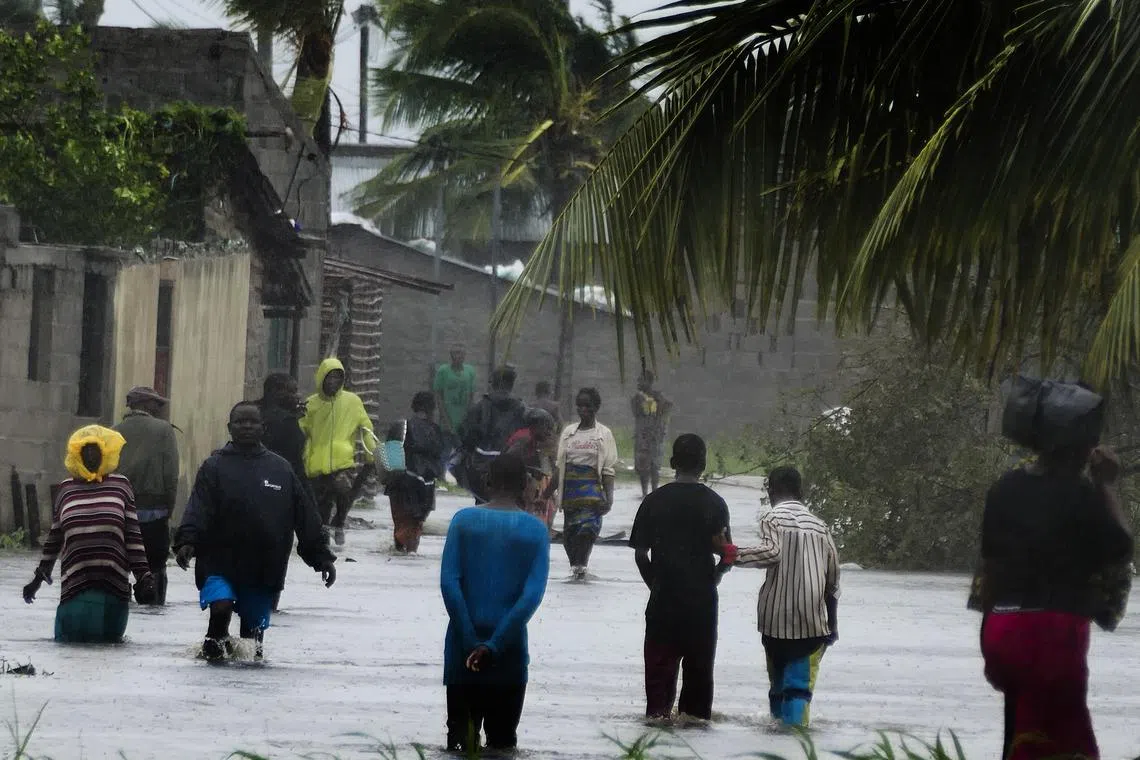Tropical Storm Freddy kills more than 100 in Mozambique and Malawi
Sign up now: Get ST's newsletters delivered to your inbox

A flooded street near the seaport of Quelimane in Mozambique on March 12, after Tropical Storm Freddy tore through southern Africa for the second time in a month.
PHOTO: EPA-EFE
Follow topic:
BLANTYRE, Malawi – Mozambique and Malawi on Monday were counting the cost of Tropical Storm Freddy, which killed more than 100 people, injured scores and left a trail of destruction as it ripped through southern Africa for the second time in a month at the weekend.
Freddy is one of the strongest storms ever recorded in the Southern Hemisphere and could be the longest-lasting tropical cyclone, according to the World Meteorological Organisation.
It pummelled central Mozambique on Saturday, ripping roofs off buildings and causing widespread flooding around the port of Quelimane, before moving inland towards Malawi with torrential rain that caused landslides.
The full extent of the damage and loss of life in Mozambique, in particular, are not yet clear, as the power supply and phone signals were cut off in some affected areas.
The storm has killed 99 people in Malawi, including 85 in the main commercial hub of Blantyre in the country’s south, said Department of Disaster Management Affairs commissioner Charles Kalemba at a press conference.
The total number killed by the tropical storm in Mozambique, Malawi and Madagascar since it first made landfall in February is now around 136.
The central hospital in Blantyre had received at least 60 bodies by early afternoon, Doctors Without Borders country director Marion Pechayre told Reuters by telephone, adding that some 200 injured people were being treated in hospital.
The injuries were from falling trees, landslides and flash floods, she said. “A lot of (houses) are mud houses with tin roofs, so the roofs fall on people’s heads.”
Police spokesman Peter Kalaya told Reuters that rescue teams had been looking for people in Chilobwe and Ndirande, two of the worst-affected townships in Blantyre, Malawi’s second-largest city, where it was still raining on Monday and many residents were without power.
“Some missing people are feared buried in rubble,” Mr Kalaya said.
Critical situation
Malawi’s national electricity company Egenco said that power generation capacity was unstable and that it had experienced a total system shutdown twice on Monday.
It has shut down all major hydropower stations to protect them from damage, it said.
At least 10 people died in Mozambique’s Zambezia province, a provincial delegate from the National Institute of Disaster Risk Management, Mr Nelson Ludovico, said on public broadcaster Radio Mozambique, adding that the figures were still provisional.
“The situation is critical in Zambezia province. We can’t advance with an accurate picture of the scale of damage because there’s no communications with all the regions,” Health Minister Armindo Tiago said on public radio.
Mr Guy Taylor, chief of advocacy, communications and partnerships for the United Nations’ children’s agency Unicef in Mozambique, told Reuters from Quelimane that humanitarian agencies there did not have the capacity to deal with a disaster of this size.
“We saw a lot of destroyed buildings and clinics. People’s homes had their roofs torn off by the wind. Even before the cyclone hit, we saw localised flooding,” he said.
The wind had died down on Monday, but there was still a lot of flooding that had destroyed crops and created a risk of waterborne diseases, he said.
Mozambique has seen more than a year’s worth of rainfall in the past four weeks.
Malawi has been battling the deadliest cholera outbreak in its history, and UN agencies have warned that the situation could now get worse.
Scientists say fossil fuel-driven climate change is making tropical storms stronger, as oceans absorb heat from greenhouse gas emissions, and when warm seawater evaporates, heat energy is transferred to the atmosphere. REUTERS

